#and look what happened
Text




i am so normal about this movie
edit: this has been getting more attention for some reason and im REALLY confused but im not complaining because this movie means so much to me and im so glad people do too! im looking forward to making more castle in the sky art, as well as ghibli art in general, so in the meantime heres some silly doodles i made of sheeta and pazu :>
#this was supposed to be ONE screenshot redraw#ONE#and look what happened#having the “fine i'll make art myself” mentality for small fandoms is fun and all until theres like 4 separate fandoms you want to make art#yea#castle in the sky#studio ghibli#also sheeta and pazu's relationship is the cutest thing ever#whether you view it platonically or romantically its still so wholesome#ghibli guys in general raising my standards for a partner :skull:#chiimo art shenanigans
3K notes
·
View notes
Photo


#star trek#strange new worlds#st snw#snw: s02e01#spock#look who finally watched the new episode#poor daddy chris#he left the keys with who he thought was the responsible child#and look what happened
261 notes
·
View notes
Text
What's the average language like?
This will be a giant of a post, because this is a subject that I really like. So much of what we think about language just isn't true when you look at the majority of them and I'm not even going into how the languages themselves are constructed, only the people speaking them, if that makes sense. It will make sense in a moment, I promise
First, let's discuss assumptions. When you think of the abstract idea of a language, what do you imagine?
How many speakers?
Where is it spoken geographically?
Do speakers of the language only speak that language or do they speak at least one other language? How many more languages?
Is the language tied to a state/country?
Is the language thriving or endangered?
In what domains is the language used? (home, school, higher education, administration and politics, in the workplace, in popular media...)
Is the language well documented and supported? Are there resources like dictionaries to look up words in, does google translate work for it, does Word/google docs work etc?
Is the language spoken or signed?
Is the language written down? Is it written down in a standardised way?
Do you see where I'm going with this? My perspective on what a language is has completely shifted after studying some linguistics, and this only covers language usage and spread, not how words and grammar work in different languages. Anyways, let's talk facts. (if no other sources are given the source is my uni lectures)
How many speakers does the average language have?
The median language has 7 600 native speakers.
7 600 people is the median number of speakers. Half the world's languages have more, half have less.
Most languages in this tournament have millions of speakers. But maybe that's relatively common? After all, half of the world's languages have more than 7 600 speakers. No.
94% of all languages have less than a million speakers.
Just so you know, big languages are far from the norm. There are 6700-6800 living languages in the world (according to ethnologue and glottolog, the two big language databases. I've taken the numbers for languages having a non-zero number of speakers and not being classed as extinct respectively. Both list more languages).
6% of 6700-6800 languages would be around 400 languages with more than a million speakers. Still a lot, but only a (loud) minority. It's enough to skew the average number of speakers per language upwards though. Counting 8 billion people and 6800 languages, that's almost 1.2 million people per language on average. The minority is Very loud.
Where are most languages spoken?
First of all, I'll present you with these graphs (data stolen from my professor's powerpoint) which I first showed in this post:
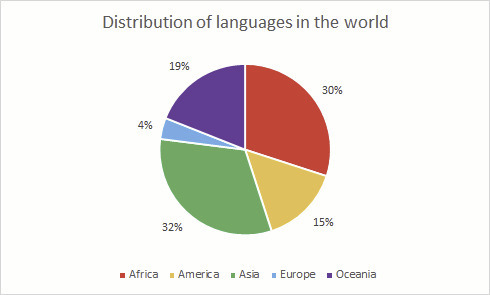
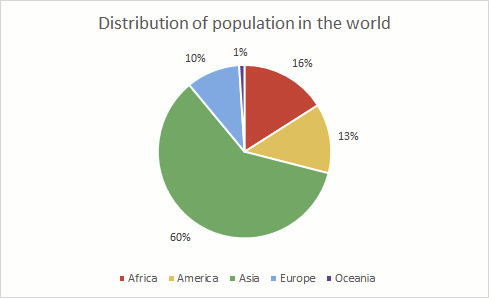
49% of all languages are spoken in Africa and Oceania, a disproportionately large amount compared to their population. On the other hand, Europe and Asia have disproportionally few languages, though Asia still has the largest amount of languages. Curious, considering Europe is often thought of as a place with many languages.
Sub-Saharan Africa is a very linguistically interesting place, but we need to talk about New Guinea. One island with 6.4 million people. Somehow over 800 languages. If you count the surrounding islands that's 7.1 million people and 1050 languages. Keep in mind that there are 6700-6800 languages in the world, so those 1050 make up more than a seventh of all languages. The average New Guinean language has less than 3000 speakers. Some are larger, but still less than 250 000 speakers. Remember, this is a seventh of all languages. It's a lot more common than the millions of speakers situation!
So yeah, many languages both in and outside New Guinea are spoken by few people in one or a few villages. Which is to say a small territory. But 7600 speakers spread over a big territory will have a hard time keeping their contact and language alive, so it's not surprising.
Moving on, lets talk about...
Bilingualism! Or multilingualism!
Is it common to speak two or more languages? Yes, it is. This is the situation in most of the world and has been the case historically. Fun fact: monolingual areas are uncommon historically and states which have become monolingual became so relatively recently.
One common thing is to learn a lingua franca in addition to your native language, a language that most people in the area know at least some of so you can use it to communicate with people speaking other languages than you.
As an example, I'm writing this in English which isn't my native language and some of you reading this won't have English as your native language either. Other examples are Swahili in large parts of eastern Africa and Tok Pisin in Papua New Guinea (the autonomous state, not the entire island).
Speakers of minority languages often have to learn the majority language in the country too. It's difficult to live somewhere where most daily life takes place in one language without speaking at least some of it. This is the case for native people in colonised countries, immigrants and smaller ethnic groups just to mention a few situations. All countries don't have majority languages, but some are larger, more influential and used for things like administration, business and higher education. It's common for schooling to transition from local languages to a larger language or lingua franca in countries with many languages.
Another approach than the lingua franca is learning the language of villages or towns surrounding you, which is very common in New Guinea and certainly other parts of the world too. It's not unusual to know multiple languages, in some places in sub-saharan Africa people speak five or six languages on a village level. Monolingualism is a weird outlier.
Speaking of monolingualism, let's move on to...
Languages and countries
This is a big talking point, mostly because it affected my view of language before I started thinking about it. First of all, I'm going to talk about the nation state and how it impacts languages within it and the way people view language (mostly because it's a source of misconceptions which fall apart as soon as you start to think about them, but if you don't the misconceptions will stay). Then I'll move on to countries with lots of languages and what happens there instead.
So, the nation state
The idea is that the people of a nation state share a common culture, history, values and other such things, the most important here being language. We can all agree that this type of nationalism has done lots of harm to various minorities and migrants all over the world, but it's still an idea that has had and still has a big impact on especially the western world. The section on nation states will focus on the West, because that's the area I know enough about to feel comfortable writing about in this regard.
How do you see this in common conceptions of language? It's in statements and thoughts like this: In France people speak French (but what about Breton? Basque? Corsican? Various Arabics? Some of the other 15 indigenous and 18 non-indigenous languages established in France? What about people speaking French outside of France?), in the US people speak English (but what about the 197 living indigenous languages? Or the 34 established non-indigenous languages? And the many extinct indigenous languages forcibly killed by the promotion of English?).
In X country people speak X, except for the people who don't, but let's ignore them and pretend everyone speaks X. Which most might actually do if it's the single national language that's used everywhere, it's common to learn a second language after all.
This is of course a simplified (and eurocentric) picture, as many countries either have multiple national languages or recognise at least some minority languages and give them legal protection and rights to access certain services in their languages (like government agency information). Bi-/multilingual signage is common and getting more common, either on a regional or a national level. Maybe because we're finally getting ready to move on from one language, one people, one state and give indigenous languages the minimum of availability they need to survive.
I wrote a long section about how nation states affect language, but I realised that veered way off topic and should be its own post. The short version is that a language might become more standardised simply by being tied to a country and more mobility among the population leading to less prominent dialects. There's also been (and still is) lots of opression and attempts to wipe out minority (often indigenous) languages in the name of national unity. Lots of atrocities have been comitted. Sometimes the same processes of language loss happen without force, just by economic pressure and misconceptions about bilingualism.
What does this have to do with the average language?
I simply want to challenge two assumptions:
That all languages are these big national languages tied to a country
That it's common that only one language is spoken within a country. If you look closer there will be smaller languages, often indigenous and often endangered. There are also countries in the West where multiple languages hold equal or similar status (just look at Switzerland and its four official languages)
Starting with the second point, let's take a look at how Europe is weird about language again
Majority languges aren't universal
I'm going to present you with a list of the 10 countries with the most living languages, not counting immigrant languages (list taken from wikipedia, which has Ethnologue as the source):
Papua New Guinea, 840 languages
Indonesia, 707 languages
Nigeria, 517 languages
India, 447 languages
China, 302 languages
Mexico, 287 languages
Cameroon, 274 languages
Australia, 226 languages
United states, 219 languages
Brazil, 217 languages
DR Congo, 212 languages
Philippines, 183 languages
Malaysia, 133 languages
Chad, 130 languages
Tanzania, 125 languages
This further challenges the idea of one country one language. Usually there's a lingua franca, but it's not always a native language and it's not always the case that most are monolingual in it (like the US or Australia, both of which have non-indigenous languages as widespread lingua francas). Europe is the outlier here. People might use multiple languages in their day to day lives, which are spoken by a varying number of people.
In some cases the indigenous or smaller local languages are extremely disadvantaged compared to one official language (think the US, Australia and China), while in other places like Nigeria, several larger languages are widely used in their respective areas alongside local languages, with English as the official language even though it's spoken by few people.
It's actually pretty common in decolonised countries to use the colonial language as an official language to avoid favoring one ethnic group and their language over others. Others simply don't have an official language, while South Africa's strategy is having 12 official languages (there are 20 living indigenous languages and 11 non-indigenous languages in total, and one of the official ones is English, so not all languages are official with this strategy either). Indonesia handled decolonisation by picking a smaller language (a dialect of Malay spoken by around 10% at the time, avoiding favouring the Javanese aka the dominating ethnic group by picking their language), modifying it, and started using it as the new national language Indonesian. It's doing very well, but at the cost of many smaller languages.
Going back to the list, it's also interesting to compare the mean speaker number (if every language in a country was spoken by the same amount of people) and the median speaker number (half have more speakers, half have less). The median is always lower than the mean, often by a lot. This means that the languages in a country don't have similar speaker numbers, so one or a few languages with lots of speakers drive the average upwards while the majority of languages are small. Just like for the entire world.
The US and Australia stand out with 12 and 10 median speakers, respectively. About 110 languages in the US have 12 or fewer native speakers. The corresponding number for Australia is 113 languages with 10 or fewer speakers. There are some stable languages with few speakers documented, but they have/had between 40 and 60 speakers, so those numbers point towards a lot of indigenous languages dying very soon unless revitalisation efforts succeed quickly. This brings us to the topic of...
Endangered languages
This is an interesting tool called glottoscope made by Glottolog which you can play around with and view data on endangered languages and description status (which is the next heading).
I'll pull out some numbers for you:
Remember those 6700 languages in Glottolog? That's living languages. How many extinct languages are listed?
936 extinct languages. That's ~12,5% of the languages we know of. (Glottolog doesn't include reconstructed languages like Proto-Indo-European, only languages where we either have enough remaining texts to conclude it was a separate language or reliable account(s) that conclude the same. We can only assume that there are thousands of undocumented languages hiding in history that we'll never know of)
How many more are on the way to become extinct?
Well, only 36% (2800 languages) aren't threatened, which means that the other 64% are either extinct or facing different levels of threat
What makes a language threatened? The short answer is people not speaking the language, especially when it's not passed down to younger generations. The long answer of why that happens comes later.
306 languages are listed as nearly extinct and 412 more as moribound. That means that only the grandparent generation and older speak it and the chain of transmission to younger generations has broken. These two categories include 9,26% of all known languages.
The rest of all languages either fall into the threatened or shifting category. The threatened category means that the language is used by all generations but is losing speakers. The shifting category refers to languages where the parental generation speaks the language but their children don't. In both of these cases it's easier to revive the language, since parents can speak to the children at home instead of having to rely on external structures (for example classes in the heritage language taught like foreign language classes in schools).
Where are languages threatened?
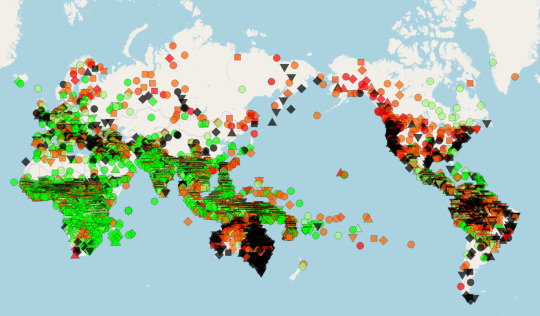
This map is also from glottoscope and can be found here. I recommend playing around with it, you can zoom in and hover over every dot to see which language it represents. The colours signify threat level: green for not threatened, light green for threatened, orange for shifting, red for moribound and nearly extinct, and black for extinct. I'll come back to the shapes later.
As you can see, language death is more common in certain areas, like Australia, Siberia, North America and the Amazon, but it's still spread over the entire world.
Why are languages going extinct?
There are two important dimensions to the vigorousness of a language: The first is the number of speakers who claim the language as their own and speak it with each other. No speakers means no language. If all speakers move to different places or assimilate by shifting to a dominant language in the area (sometimes for work opportunities or for their childrens' future work opportunities. Sometimes because of which language(s) schools are taught in or disinterest from the children in the language and culture. Sometimes migration of an ethnic group for various reasons leads to language shifts. There are many complex reasons to why the link of transmission can break)
The other dimension, which ties into the first one, is the number of situations in which a language is used. There are many domains a language can be used in, like at home, in school, in the workplace, in politics and administration, in higher education, for international communication, in religious activities, in popular media like movies and music etc. When a language is no longer or never used in a particular domain, it might lose the associated vocabulary. When it becomes confined to a singular domain like the home, the usage goes down. The home is usually the last place an endangered language is spoken.
Usage in a domain is a reason to speak or hear the language. It's a reason to keep it alive. People also forget or get worse at languages they don't use. That's why a common revitalisation tactic is producing movies, radio programmes, news reporting, books and other media in a dying language. It gives people both reason and opportunity to use their language skills. Which language is used in schools is also important, as it keeps basic vocabulary for sciences and explaining the world alive. Another revitalisation tactic is making up new words to talk about modern concepts, some examples are the Kaqchikel word rub'eyna'oj from this tournament or creating advanced math vocabulary in Māori.
What does endangered languages have to do with the average language?
Trying to get this post back on track, these are some key points:
64% of all documented languages are either extinct or facing some level of threat. That's the majority of all language
Even excluding the extinct languages, the majority of languages are threatened or worse
This means that the average language is facing a loss of speakers, some more disastrous than others. Being a minority language in an increasingly globalized world is dangerous
Describing a language
Are you able to look up words from your native language in a thesaurus or a dictionary? What about figuring out how a certain piece of grammar works if you're unsure? Maybe you don't need that for your native language, but what about a second language you're learning?
If your native language is English, there are lots of resources, like online and book dictionaries/thesauruses or an extensive grammar (a book about how English grammar works). There's also a plethora of websites and courses to learn English, and large collections of written text or transcribed speech. If a linguist wants to know something about the English language there's an abundance of material. If someone wants to learn English it's easy and courses are offered in most parts of the world.
For other languages, the only published thing might be a list of 20 words and their translation into English or another lingua franca.
Let's take a look at the same map as earlier, but toggled to show documentation status in colour and endangerment status with shapes:
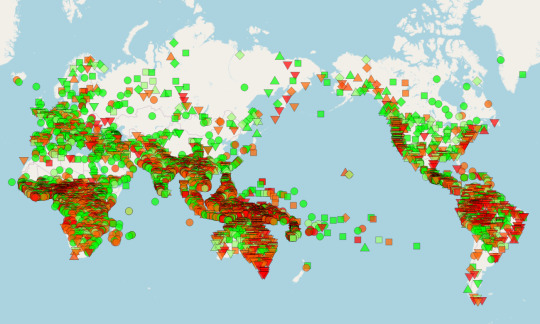
Here, the green signifies a long grammar and the light green a grammar. Both are extensive descriptions of the grammar in a language, but they differ in length. A long grammar has to contain over 300 pages and a grammar over 150. Orange is another type of grammar, namely a grammar sketch. Those are brief overviews of the main grammatical features or features that may be of interest for linguists, typically between 20 and 50 pages. The purpose isn't to be a complete grammar, only a starting point.
The red dots can signify a lot of things, but what they have in common is that there's no extensive description of the grammar. In those cases, the best description of the language might be a list of which sounds it contains, a paper about a specific feature, a collection of texts or recordings, a dictionary, a wordlist (much shorter than dictionaries) or just a mention that it exists.
Why are grammars and descriptions even important?
The better described a language is, the easier it is to learn it and study it. For a community facing language loss, it might be helpful to have a pedagogical grammar or a dictionary to help teach the language to new generation. If the language becomes extinct people might still be able to learn and revive it from the documentation (like current efforts with Manx). It also makes sure unique words or grammatical features as well as knowledge encoded in the language isn't lost even if the language is. It's a way of preserving language, both for research and later learning.
What's an average amount of descripion then?
36,2% of all documented languages have either a grammar or a long grammar. That's pretty good actually
38,2% of all documented languages would be marked by a red dot on this map, meaning that more languages than that don't have any kind of grammar at all, maybe only as little as a short list of words
The remaining 25,6% have a grammar sketch
So as you see, the well documented languages are in minority. On the brighter side, linguists are working hard at describing languages and if they keep going at the same rate as they have since the 1950s, they'll reach the maximum level of description by 2084. Progress!
Tying into both description of languages and domains where language is used...
What about technology and language?
There are many digital tools for language. Translation services, spelling and grammar checks in word processors, unicode characters for different scripts and more. I'm going to focus on the first two:
Did you know that there are only 133 languages on google translate? 103 more are in the process of being added, but that's still a tiny percentage of all languages. As in 2% right now and 3,5% once these other languages are added going with the 6700 language estimation.
Of course, this is for the most part a limination with translation technology. You need translated texts containing millions of words to train the algorithms on and the majority of languages don't have that much written text, let alone translated into English. The low number still surprised me.
There are 106 official language packs for Windows 10 and I counted 260 writing standards you can use for spelling checks in Word. Most were separate languages, but lots were different ways to write the same language, like US or British English. That's a vanishingly small amount. But then again:
Do all languages have a written standard?
No. That much is clear. But how many do? I'll just quote Ethnologue on this:
"The exact number of unwritten languages is hard to determine. Ethnologue (25th edition) has data to indicate that of the currently listed 7,168 living languages, 4,178 have a developed writing system. We don't always know, however, if the existing writing systems are widely used. That is, while an alphabet may exist there may not be very many people who are literate and actually using the alphabet. The remaining 2,990 are likely unwritten."
(note that Ethnologue classes 334 languages without speakers as living, since their definition of living language is having a function for a contemporary language community. I think that's a bad definition and that means it differs from figures earlier in the post)
Spoken vs signed
My last point about average languages is about signed languages, because they're just as much of a language as spoken ones. One common misconception is that signed languages reflect or mimic the spoken language in the area, but they don't. Grammar works differently and some similarities in metaphor might be the only thing the signed language has in common with spoken language in the area.
Another common misconception is that there's only one sign language and that all signers understand each other. That's false, signed languages are just as different from each other as spoken languages, except for some tendencies regarding similarity between certain signs which often mimic an action (signs for eating are similar in many unrelated sign languages for example).
Glottolog lists 141 Deaf sign languages and 76 Rural sign languages, which are the two types of signed language that become entire languages. The difference is in reach.
Rural signs originate in villages with a critical amount of deaf people (around 6) that make up a fully fledged language with complete grammar to communicate. Often large parts of the village learn tha language as well. There are probably more than 76, that's just the ones the linguist community knows of.
What's called Deaf sign languages became a thing in the 1750s when a French guy named Charles-Michel de l'Épóe systematised and built onto a rural sign from Paris to create a national sign language which was then taught in deaf schools for all deaf children in France. Other countries took after the deaf school model and now there's 141 deaf sign languages, each connected to a different country. Much easier to count than spoken languages.
Many were made from scratch (probably building on some rural sign), but some countries recruited teachers from other countries that already had a natinonal sign language and learnt that instead. Of course they changed over time and with influence from children's local signs or home signs (rudimentary signs to communicate with hearing family, not complete languages), so now there's sign language families! The largest one unsurprisingly comes from LSF (Langue des Signes Française, the French one) and has 63 members, among them ASL.
What does this have to do with average languages? Well, languages don't have to be spoken, they can be signed instead. Even if they make up a small share of languages, we shouldn't forget them.
Now for some final words
Thank you for reading this far! I hope you found this interesting and have learned something new! Languages are exciting and this doesn't even go inte the nitty gritty of how different languages can be in their grammar, sounds and vocabulary. Lots of this seem self evident if you think about it, but I remember how someone pointing out facts like this truly shifted my perspective on what the language situation in the world truly looks like. The average language is a lot smaller and diffrerent from the common idea of a language I had before.
Please reblog this post if you liked it. I spent lots of time writing it because I'm passionate about this subject, but I'd love if it spread past my followers
#linguistics fun fact time!#anyways can't believe this is finally done#i was going to make a series with informative posts between each round#and look what happened#i spent all my time writing this instead#hope you enjoyed!#and check out the linguistics fun facts tag#there are some more posts like this#linguistics
74 notes
·
View notes
Text
just thinking about how Juno taking it as a sign of undying love was what Peter saw as a sign of love being able to die. they both know how fragile it is to find someone you dare to set your heart on and despite all the chaos of running from their beginnings they found each other, it was a chance. that's all Juno needed, a chance. that's all he wanted. and how agonising it must have been for Peter to see that extending hand escape the detective they always thought of as reserved. but for Peter, never again. never again could they let someone they love be consumed by the vapid cruelty of this side of the galaxy.
#the penumbra spoilers#the penumbra podcast#tpp#junoverse#juno steel#peter nureyev#tpp peter#tpp juno#pls help i just cant stop thinking about what Juno will not open up about anymore because this was his sign to go for it#and look what happened
65 notes
·
View notes
Text
If Akira has millions of fans, i am one of them.
if Akira has ten fans, i am one of them.
if Akirs has only one fan, that is me.
if Akira has no fans, that means i am dead.
if world's against Akira, i am against the world.

23 notes
·
View notes
Text
fantasizing about having kids is dangerous cause i think about all the ways i would treat my kid better than how i was treated but i’m sure my mom thought the same thing
13 notes
·
View notes
Text
pre game thoughts:
LOCK THE FUCK IN REDMEN! we CANNOT concede first this time! this is a moment to make klopps last season special and no matter WHO we have injured, we can still win this
#salah was out during that cl semifinal if i’m not wrong#and look what happened#don’t lose faith reds!!!
9 notes
·
View notes
Text
Logging off? @photomatt has never heard of it.

I commented on @predstrogen’s twitter abt how my old blog also got nuked for bullshit reasons and lo and behold. Never interacted with the man.
#i commented on predstrogens twitter post abt how tumblr nuked my old blog for no reason#and look what happened#wheres that sabbatical babes#i blocked him on here a looooong time ago
9 notes
·
View notes
Note
So fans of the main character are the wrong people now? Lol, okay.
Which is completely idiotic because the OP tagged it with Supernatural and Sam Winchester. What did they think was going to happen? LMAO!
(I can guess that they probably thought hellers have scared off all Sam fans from even searching his tag because they tag his name unnecessarily in so many of their Destiel posts.)
On a side note: I know this used to be considered the "Heller" site, but based on a lot of recent follows, I get the impression that since the show ended, new fans of SPN creating Tumblr accounts aren't getting brainwashed by hellers into thinking Destiel might go canon, because they either know it didn't, or encountered hellers in other spaces and were annoyed by their toxicity. (Though that could just be me hoping, lol!)
#ask box#anti hellers#OP of the poll mostly tagged correctly#and look what happened#sam fans showed up#lol!
9 notes
·
View notes
Text
(As an aside, I love all the twitter artists returning to tumblr
it’s like “weel weel weel look who’s come CRAWLING BACK to this hellhole ;)” )
#i say it with love#but let’s be real some of us idiots stuck it out stubbornly#AND LOOK WHAT HAPPENED#naughty art excluded man I get it u_u
51 notes
·
View notes
Text
watching the episode of parts unknown where Bourdain visits Gaza is so heartbreaking now—more so than before because i find myself wondering how many of those wonderful smiling people that he talks to are still here with us. israel is genuinely sick for what they’ve done to Gaza and the Palestinian people
#snail thoughts#idk if it’s the lack of sleep but i’ve been wanting to cry this whole episode#they’re all so optimistic for the future#and look what happened#free palestine
2 notes
·
View notes
Text
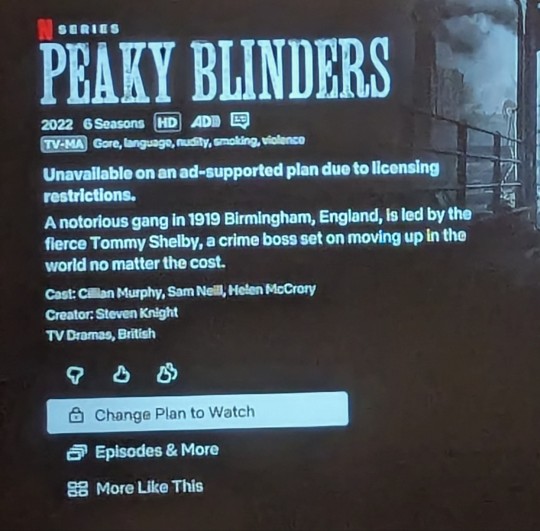
this is actually so sick, i just wanted cillian murphy and crime, is that too much to ask❓❓❓
#SICK#this is why netflix is the absolute worst#it used to be sooooooo good#and look what happened#peaky blinders#cillian murphy#netflix
4 notes
·
View notes
Text
Elle is so compassionate in season one of cm and I am forever annoyed that people take her PTSD arc, which is in itself powerful because it shows such a huge departure from how she normally acts and illustrated the tragedy of her team not having her back, to make out that this is her base personality.
Elle is not mean, she's not cruel, she is always thinking of making victims comfortable or reassuring witnesses that they have no logical reason to feel guilty and it's not their fault.
That what happened, that her having no support from her team (to be fair, some of them Wanted to help and raise concerns and are silenced) drove her to where she ended up is a tragedy that you miss the poignancy of if you are deadset on ignoring her Actual characterisation for seemingly no reason.
#cm shit#she needed Help#she needed to be told no for her own benefit#she was failed#and look what happened
6 notes
·
View notes
Photo

28 notes
·
View notes
Text
mike really does predict the future i think... he was definitely thinking about murdering jason here

#and look what happened#byler#(mike’s monologue indirectly opened the gate that killed jason u get it)
24 notes
·
View notes
Text
tomorrow is my birthday. i'm on vacation in my home city by the sea, my pain level is a 10/10, my time has been spent mostly sobbing because my body hurts that much, i haven't slept in two days because of the pain i'm in (despite the fact that i'm fucking exhausted), and i will likely be spending today and possibly tomorrow in the hospital. the lesson i've learned is that i definitely need to stop trying to do nice things for myself because when i do literally everything goes wrong.
#this trip was cursed from the get go and everything has gone wrong. i got to enjoy a single day#one single day#i knew this trip was a bad idea#i had this weird feeling about it for months but i ignored it because i wanted to go home for my birthday#and look what happened#worst part is that it's likely destroyed the entire month#the one month of the year i wanted to enjoy and this happens#why do i even try lol#personal
2 notes
·
View notes